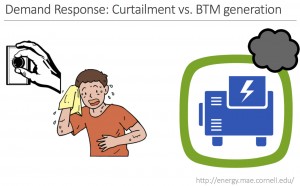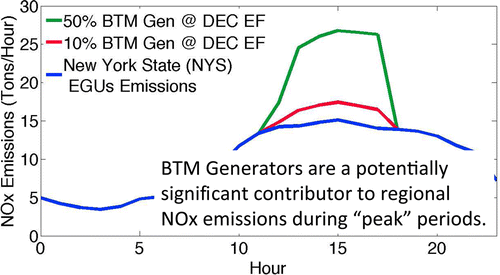Power system operators resort to demand response (DR) programs to reduce demand during critical hours, which typically happen on only a few days in a year, but have become important reliability resources. Participants enrolled in DR programs can respond via load curtailment (i.e., load shedding and/or shifting) or behind-the-meter (BTM) generation. BTM generators enrolled in the DR programs are almost exclusively diesel backup generators [1].
We investigated the implications of BTM generation participating in DR programs. Specifically, we evaluated the impacts of NOx emissions from BTM generators enrolled in the New York Independent System Operator (NYISO)’s reliability-based DR programs. Through analyzing the DR program enrollment
data, DR event records, ozone air quality monitoring data, and emission characteristics of the generators, we found that the emissions from BTM generators very likely contribute to exceedingly high ozone concentrations in the Northeast Corridor region, and very likely account for a substantial
fraction of total NOx emissions from electricity generation.
In addition, a companion study showed that the emissions from BTM generators could also form near-source particulate matter (PM) hotspots [2].
The important policy implications are that the absence of up-to-date regulations on BTM generators may offset the current efforts to reduce the emissions from peaking power plants, and that there is a need to quantify the environmental impacts of DR programs in designing sound policies related to demand-side resources [1]. Furthermore, we proposed the concept of “Green” DR resources, referring to those that not only provide power systems reliability services, but also have verifiable environmental benefits or minimal negative environmental impacts [1]. We argue that Green DR resources that are able to maintain resource adequacy and reduce emissions at the same time are key to achieving the cobenefits of power system reliability and protecting public health during periods with peak electricity demand.
In general, Green DR resources include measures for load curtailment and clean distributed generation. BTM generators with the latest emission control technologies, such as those meeting Tier 4 emission standard, and with rigorous siting designs, can potentially become part of Green DR resources. Moving forward, we recommend that Green DR resources should be differentiated from the polluting ones, and incentivized for their societal and economic benefits. Furthermore, the participation of low-emitting hydrocarbon-fueled generation in DR programs should not hinder the deployment of nonemitting generation that can reduce the electricity demand during the “peak” periods.
Related Publications
1. Zhang, X.; Zhang, K. M., Demand Response, Behind-the-Meter Generation and Air Quality. Environmental Science and Technology, 2015, 49 (3): 1260-1267
2. Tong, Z.; Zhang, K. M., The Near-Source Impacts of Diesel Backup Generators in Urban Environments. Atmospheric Environment, 2015, 109: 262-271


